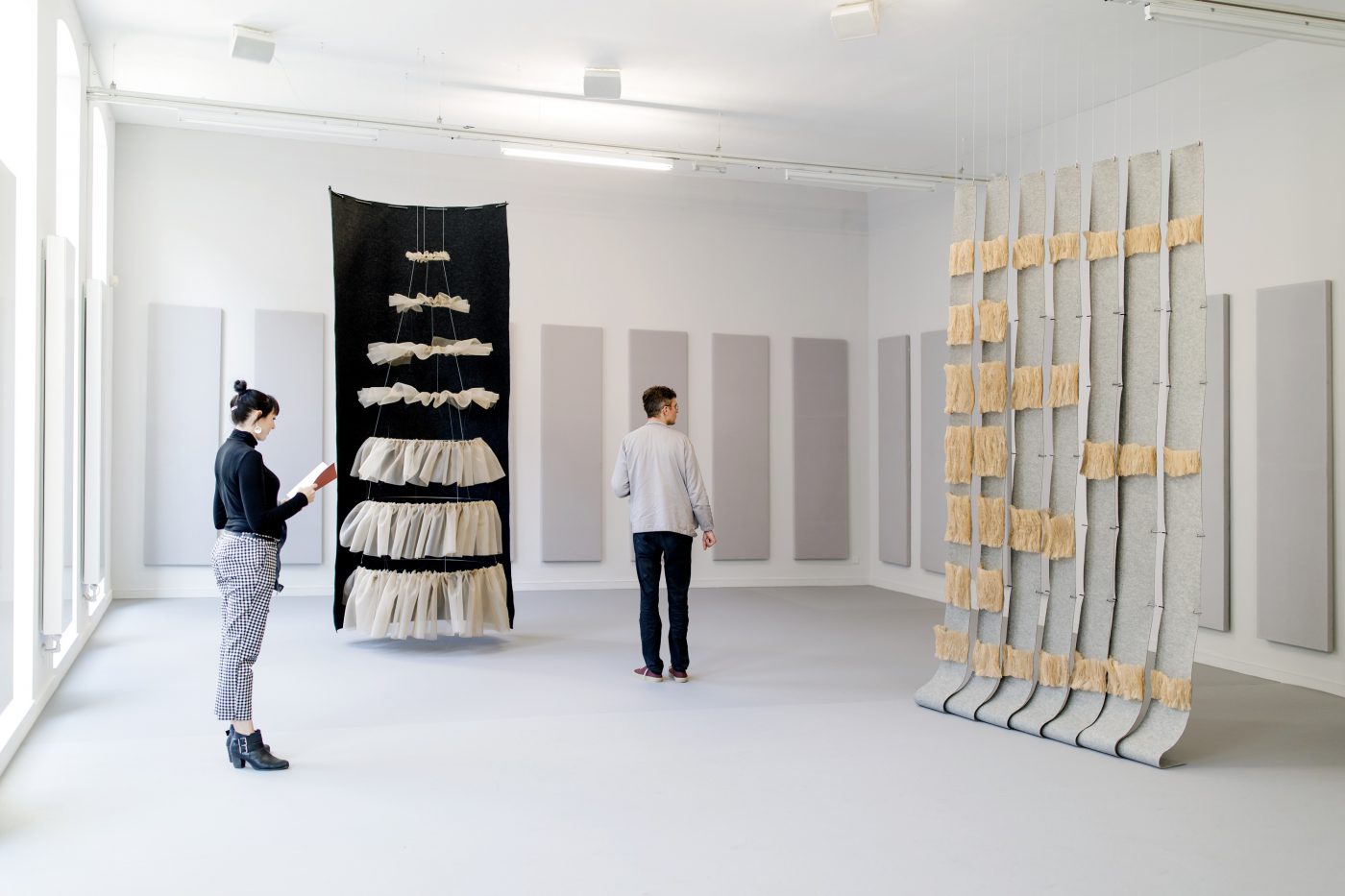
Work by Mercedes Azpilicueta and John Bingham-Hall in Post-Opera
To obtain a voice (in our own affairs) – Post-Opera at TENT
Post-Opera seeks a bold contemporary redefinition of opera. One that is premised on a belief that the voice-body relationship, which has been historically overlooked within the art form, is itself a producer of meaning.
The first microphone wasn’t invented until 1876: some 279 years after the birth of opera. As such, the operatic singing voice was developed before electronic amplification, fortuitously postponing opera’s current reckoning with and dependence on modern technology. This seems to be the overture to Post-Opera, the current exhibition at TENT, Rotterdam, curated by Kris Dittel and Jelena Novak.
In recent years opera has undergone a technological shift. The introduction of supertitles in the 1980s was the result of much criticism amongst opera loyalists who believed that the purity of experience was disrupted by the desire for translation. Then, at the turn of the twenty-first century, we saw opera move from stage to big screen, with the Metropolitan Opera in New York launching their Metropolitan Opera Live in HD series, transmitting their performances internationally to rave review. As the average viewing age for opera currently stands at sixty years old, it seemed an engaged business move to embrace the possibilities of stage meets technology. Moreover, with the backbone of the state propping it up—look at any national culture budget in the West and you would be hard-pressed to find national opera houses going without—this common binary of specialisation versus accessibility is exacerbated by the demand for audience engagement set by funding bodies searching for quantifiable results.
Yet, Post-Opera figures the role of technology in a different way—albeit one still concerned with the public sphere and amplification. The exhibition takes Jelena Novak’s research on ‘post-opera’ as a starting point—a genre that seeks a contemporary redefinition of opera, premised on a belief that the voice-body relationship, which has been historically overlooked within the art form, is itself a producer of meaning—to investigate perspectives within the visual arts, technology and opera that focus on the relationship between the human body and the voice.
Despite there being no linear chronology necessarily put forth by the install of the exhibition, there is one work that flags a sort-of beginning. A book illustration of Athanasius Kircher’s Speaking Statues (1650) shows a “piazza listening-device”. What looks like an inverted megaphone is buried within the wall that separates a public square and the chambers on the upper floors of a neighbouring building. Lodged on a diagonal incline, the wide end of the megaphone opens into the square and the sound of people engaging in civic life travels through the funnel, to be transmitted via a small opening at the other end —which happens to be embedded in a sculptural bust installed in the private chamber of an eavesdropping aristocrat. That this is the oldest work in the exhibition is not why it stands as a beginning. With the exhibition foregrounding the changing relationship between the body, the voice, publicness and technology today—the catalogue states that the voice is central to the conception of citizenship—there is something eerily contemporary about this device. Its function is essentially one of surveillance, and it speaks to the mediation of public life brought on and exacerbated by recent developments in social technologies and their networks.
[blockquote]Rather than being an exhibition solely about the structures of amplification, mediation and control that the voice is pushed through, Post-Opera is more a tribute to the guttural endurance of the voice itself, and its prevalence despite these odds
Carrying on with this theme, and installed just opposite, is A Truly Magical Moment (2016) by artist and composer Adam Basanta. In attempting to bridge the gap produced by these technological infrastructures, Basanta’s interactive sculpture uses Facetime, the internet and an instruction to assist a couple “interested in being reunited” to share in a moment of eye-gazing, world spinning dance—camera-work most often utilised during moments of dizzying, romantic euphoria experienced only in Hollywood films is reproduced via a 360-degree rotating apparatus—to the fragmented soundtrack of three operas: Romeo and Juliet, Madame Butterfly and Reunited. When two external numbers call the iPhones embedded in the sculptural apparatus, it activates the kinetic work to spin from its central axis. The work clearly articulates the disassociation of body from voice experienced through technology-based communication (and attempts to dislodge this with cinematic manipulation), but also manages to, perhaps unknowingly, institute the unease that is growing around informational accountability within this realm. I felt uneasy as my number was beamed onto the screen of the iPhone, for all of the audience to see—thereby forcing the encouraged moment of intimacy firmly into the sphere of visibility.
Other works in the exhibition approached the question of amplification from the perspective of a collective whole. Paul Elliman’s opening-night performance How we learn the old songs brought together a group of singers who at different intervals—starting as individual enunciations and then growing into a collective sound—attempted to reproduce the sounds of emergency vehicles. Rushing to the scene of a fictional crime, or fire, or accident, the voices juxtaposed the dramatics of performance with the dramatics of civic life: the crime transforms the private citizen into a public figure. Here, the historical lineage of opera’s roots in Greek tragedy took its most clear reincarnation. Ho Tzu Nyen’s 3D animation No Man II (2017) also addressed the individual and the collective. His fantastical film depicted the slow dance of other-wordly figures—from animals to robots to human-animal hybrids—to the sung chorus of John Donne’s canonical poem No Man Is an Island (1624). Yet the strange lyricism of this digitally rendered work was interrupted intermittently by a spotlight that temporarily engulfed the room, leaving you staring starkly back at your own reflection in the panels of spy mirror that the film was otherwise secretly projected on.
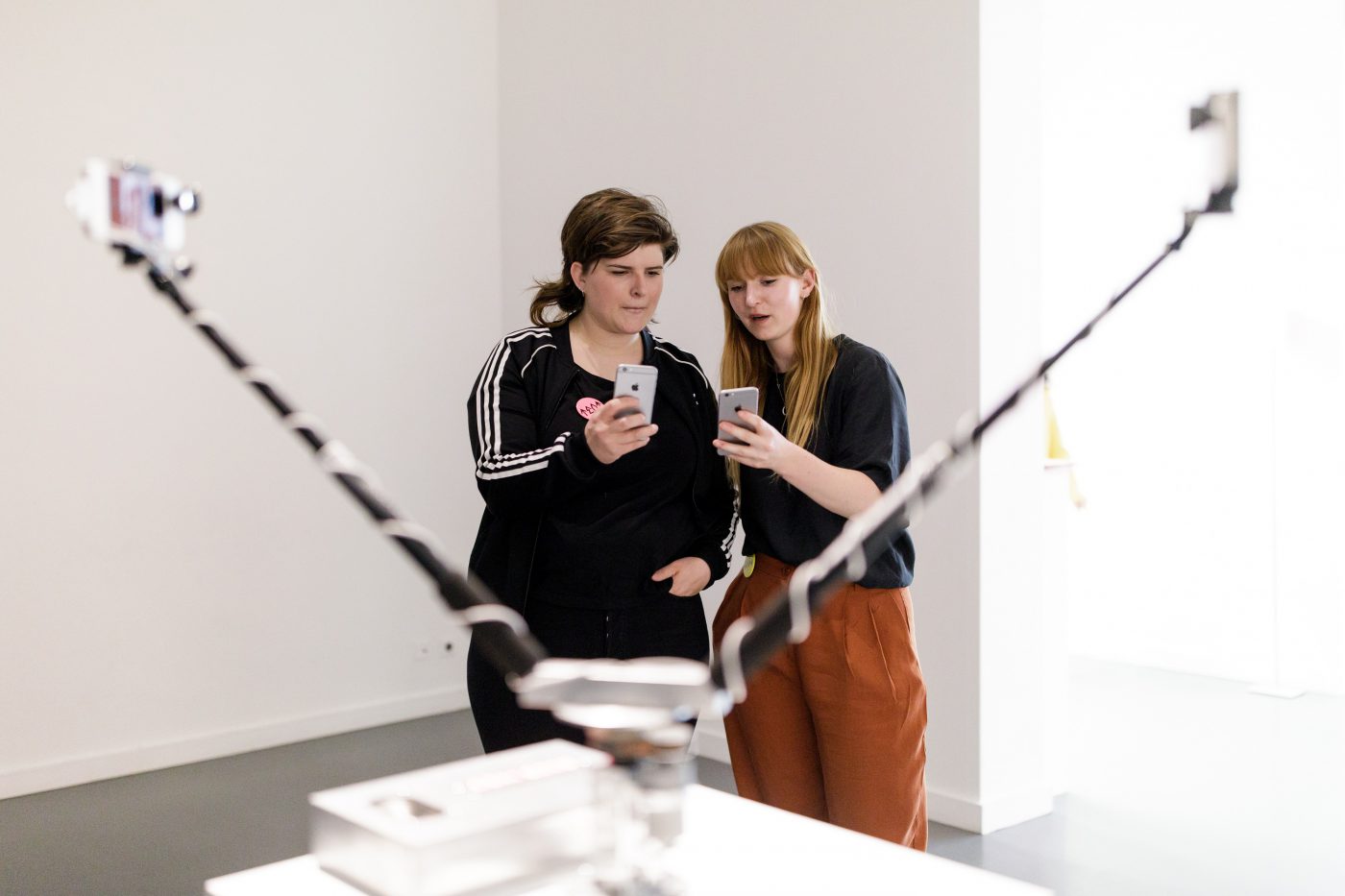
Work by Adam Basanta in Post-Opera
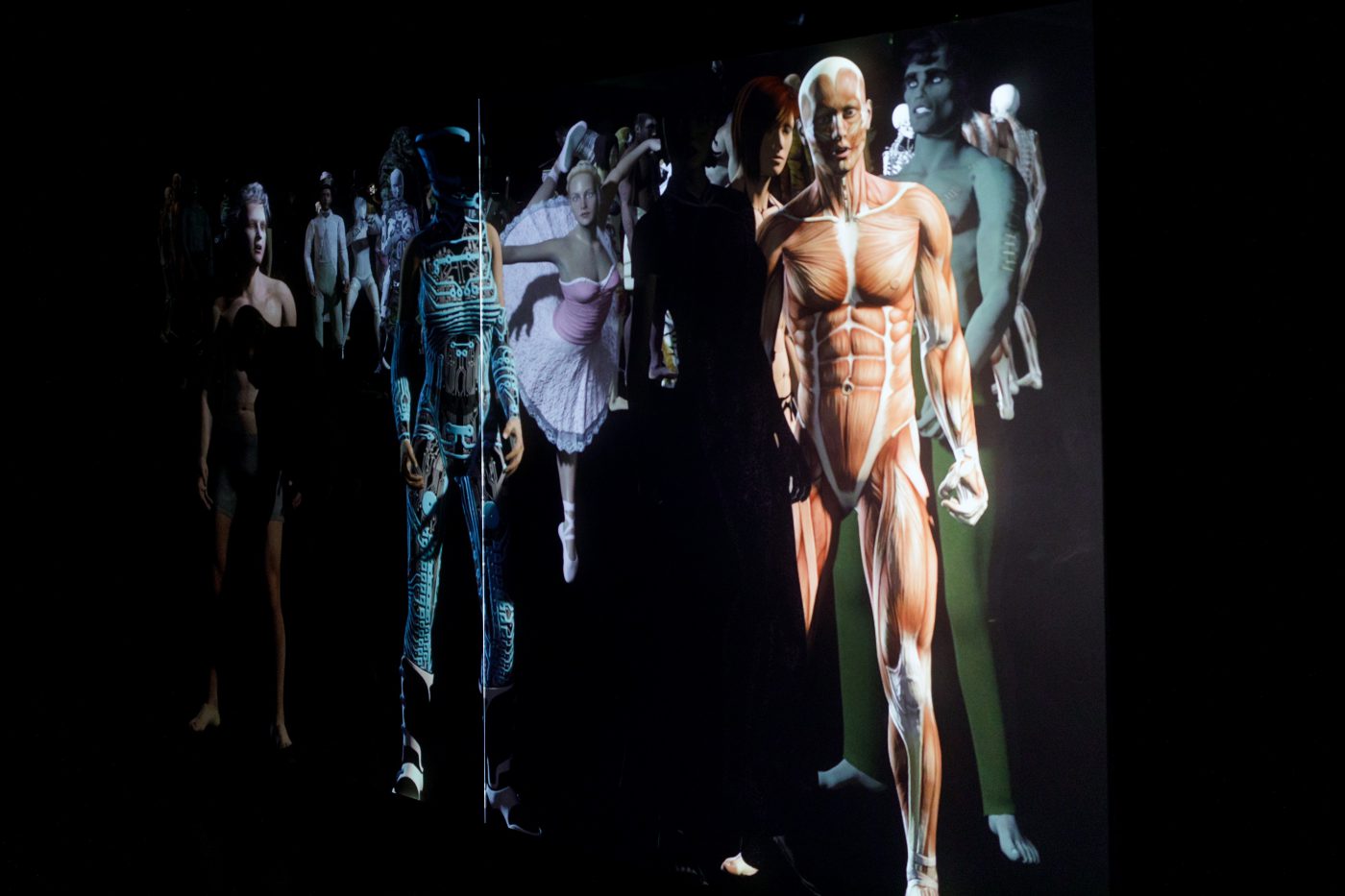
Work by Ho Tzu Nyen in Post-Opera
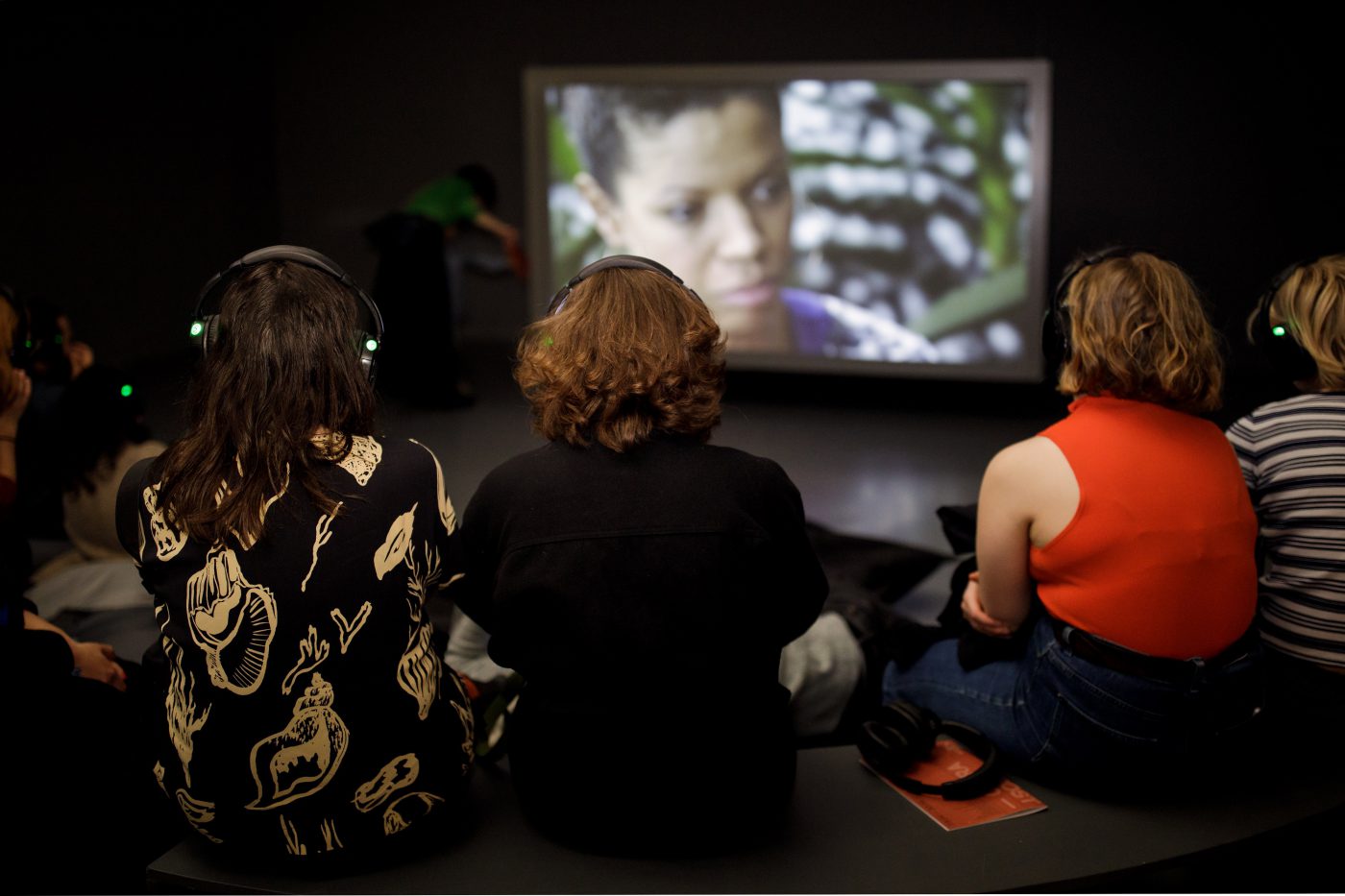
Work by Katarina Zdjelar in Post-Opera
This spotlight is used as a motif throughout other sections of the exhibition also, activating different works at different intervals. Jasna Veličković’s three-part installation Opera of Things (2019) benefits most notably from this. When static, the work appears as a Velicon—an instrument invented by Veličković herself—and two sets of power adaptors unplugged on plinths, almost as if they were accidently left behind by the install team in the frantic race to the finish. But when activated, the inanimate objects intervene in the soundtrack of the exhibition through recorded audio produced by the Velicon and the adaptors. The instrument produces sound through a magnetic process, one that Veličković similarly applied to the power adaptors in order to extract their inner ‘voice’. Here, technology is figured as an enhancement, dislocating the human-centric experience in favour of an intimacy of objectness.
Tom Johnson’s aria, The Audition (2019), for Martin Riches Singing Machine (2010–2013) also plays with the idea of technology as enhancement. And while I wasn’t present for its activation, I imagine it would benefit from the spotlight motif too. The score begins: “I must explain, I have a speech impediment, I can only pronounce vowels. So you have to read the text, but that is true in many operas today.” Drawing on the changing landscape of the viewing experience of opera, Johnson offers a way forward in which the impact of new media has generated inclusivity within the art form, while simultaneously satirising its apparent demise at the hands of its own traditionalisms.
At times, the spotlight motif leaves the exhibition hovering weirdly, almost accidently, between the theatrics of the stage and the institutional language of museum spaces (the darkened room and the spot-lit work is becoming seen as increasingly unfashionable in contemporary neon-lit spaces). The soundproofing in the room that houses Mercedes Azpilicueta and John Bingham-Hall’s sound and sculptural installation Scores for Rotterdam (2019) also appears as much aesthetic as functional, as if consecutive monochrome sculptures have been affixed to the surrounding walls like a frame. Yet this activation of the apparatuses of presentation speaks loudly and clearly, without any need for amplification, to the grammar of opera itself.
Suddenly, the supertitles and the live streams stand not just as an attempt to salvage a dying medium from its literal dying audience, but also as a means to understand the limits of the singing body. After all, supertitles were developed not just to address the language barrier produced by operas largely being performed in their written tongue, but also because sung discourse is much harder to understand than spoken discourse, even when the native tongue is concerned. Here, Post-Opera stages its most potent offering: rather than being an exhibition solely about the structures of amplification, mediation and control that the voice is pushed through, it is more a tribute to the guttural endurance of the voice itself, and its prevalence despite these odds. From here, the more successful works in the exhibition actively dislocate the image of the singer from that which is sung, activating the body as instrument and propelling forth new ways in which to feel ownership in expression eventuate.
LEES OOK HET KUNSTENAARSPROFIEL ‘GRAPPIG, ONGEMAKKELIJK, ONGRIJPBAAR’ OVER MERCEDES AZPILICUETA IN Metropolis M Nr 2-2019 Magisch Realism & Venice Biennale 2019 Guide. BESTEL BIJ: [email protected]
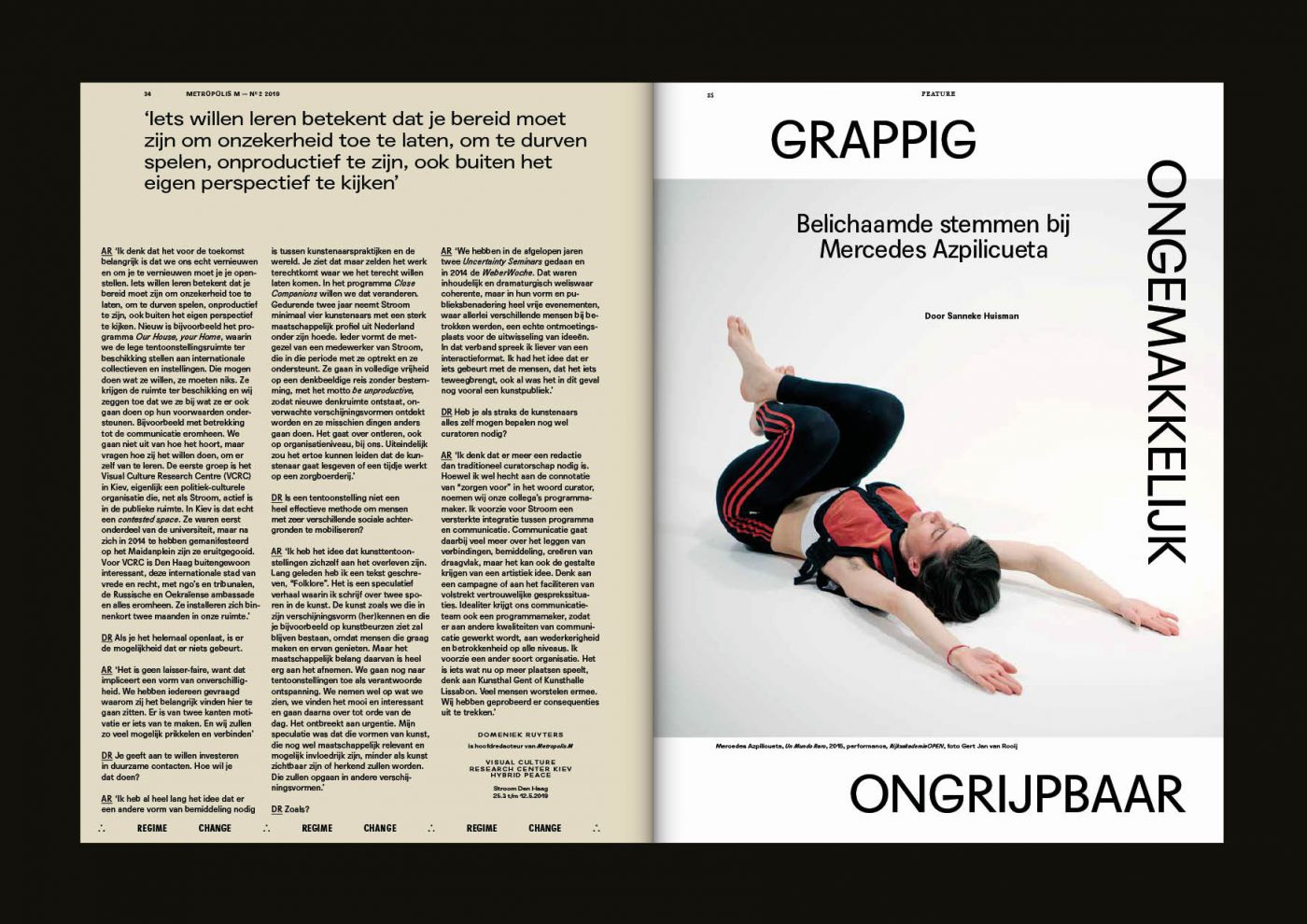
All photos are of the opening night, photographer: Aad Hoogendoorn.
Post-Opera runs until June 30, with a rigorous events program running throughout. At the time of writing, Paul Elliman’s performance was the only event within the program that had occurred. See www.tentrotterdam.nl for more information.
Post-Opera, curated by Kris Dittel and Jelena Novak, with work by Mercedes Azpilicueta & John Bingham-Hall, Adam Basanta, Paul Elliman, franck leibovici, Ho Tzu Nyen, Janneke van der Putten, Uro Shirhan, Martin Riches & Tom Johnson, Jasma Veličković, Suzanne Walsh, Geo Wyeth, Katarina Zdjelar and Jan Adriaans, on view until 30.06.2019
Isabelle Sully
is an artist and writer


